Portable storage needs cover a wide range of situations. For some content creators, and I’ve seen this a LOT with YouTubers, it might be normal to regularly pick up large external hard drives to fill up and to store away like they are old video tapes. Or maybe you travel or take your data with you to places like work. Well, there is a point in drive size where even just getting the data on or off of your drive is going to take far too long to get it done with a spinning disk. There are standard flash solutions and SATA-based SSD options. But if you are moving a lot of data around the only real solution is an NVMe based external. The Extreme Pro Portable SSD V2 that SanDisk sent over fits in that category. With an impressive 4TB capacity, it is up in the same range as a portable hard drive but you aren’t going to spend all day getting your data off of it. Today I’m going to check out how the drive compares to the last few SanDisk drives we have had in the office and then check out its performance as well.
Product Name: SanDisk Extreme PRO Portable SSD V2 4TB
Review Sample Provided by: SanDisk
Written by: Wes Compton
Amazon Affiliate Link: HERE
|
Specifications |
|
|
Capacities Available |
1TB, 2TB, 4TB |
|
Interface |
USB 3.2 Gen 2 x2 |
|
Connector |
USB-C |
|
Compatibility |
USB 3.2 Gen 2x2 (20Gb/s), USB 3.0, USB 2.0 |
|
Dimensions (L x W x H) |
4.34" x 2.26" x 0.4" |
|
Sequential Read Performance |
2000MB/s |
|
Sequential Write Performance |
2000MB/s |
|
Operating Temperature |
0c to 45c |
|
Storage Temperature |
-20c to 85c |
|
Durability |
IP55 water and dust resistance |
|
Shock Resistant |
Up to 1500G |
|
Vibration Resistant |
5 gRMS, 10-2000 Hz |
|
In The Box |
Extreme PRO Portable SSD USB-C to USB-C Cable USB-C to USB-A Cable Safety and Warranty Guide |
|
Warranty |
5-Year Limited Warranty |
Photos and Features
SanDisk hasn’t changed up their packaging at all from the last time I had one of their external drives in the office. The box for the Extreme Pro Portable SSD has a black background and down on the bottom, there is a red stripe with the SanDisk logo. They have a picture of the drive on the front which looks like it is splashing into water to show off its water and dust resistance. The SanDisk logo is repeated again up top along with the model name which is in gold. This is the Extreme Pro Portable SSD V2 though and the packaging doesn’t indicate this is the v2. Then on the right side, they have the drive size which ours is the huge 4TB model, and below that they have the drive speeds for read and write which are listed as 2000 MB/s on both. Around on the back, they highlight a few of the drive's features like being an NVMe drive, its ruggedized design, the size, and type-c support including smartphones. Each of those are then repeated in 5 more languages. The only other thing on the back is that they have a badge for the 5-year warranty. The rest is filled with the normal fine print.


Inside of the box, the Extreme PRO Portable SSD V2 comes in a thin plastic tray and with a strip of plastic around the drive which I assume is to keep it from rubbing on things in the box. Below the drive, they have the documentation which is just a safety and warranty guide in the tray as well. The tray also had the two different USB cables packed in it as well, both in its own plastic bag.



So the Extreme PRO Portable SSD V2 comes with two cables, both are around a foot long and both have a Type-C connection on one end for connecting to the drive. On the other end, one cable is Type-C and the other is a more traditional Type-A connection. I like the SanDisk went with two different cables for this, not the small C to A adapter that are easy to lose.


SanDisk stuck with a similar look to their past Extreme portable SSDs for the Extreme PRO Portable SSD V2. The drive has a rubberized coating on the sides to give a little grip as well as the loop in the top corner that you can hang the drive from or use with a lanyard or a carabiner. The drive is 2.26 inches wide and 4.34 inches tall then .4 of an inch thick. The Extreme PRO Portable SSD V2 isn’t the smallest portable SSD out there with those dimensions but it is still small enough to slide into a pocket easily.





The Extreme PRO Portable SSD V2 has a base aluminum frame which is where it gets most of its durability from. That is the orange that you see in the loop in the corner. Then over top of that, they have given it a rubberized finish and the top has an extra thick rubber finish with dimples for even more grip. The aluminum frame is what keeps the Extreme PRO Portable SSD V2 strong from drops, the rest is there to try to prevent falls from happening in the first place. It is officially IP55 rated which means it can keep dust and water out but it isn’t fully protected from either. In other words, it can handle water being sprayed at it, but it cant be submerged. On the back and front of the drive, they have the SanDisk logo in the center. On the back, they also have all of the normal certification logos as well as the serial number and full model number. The model name here also doesn’t include the V2 just like on the packaging which could cause some confusion. But just know the new drive is the one that lists the read and write speed as 2000 whereas the old drive was half that. The aluminum frame does wrap around the drive with a rubber bumper to take up any initial hits. Then down at the bottom edge, the Extreme PRO Portable SSD V2 has a Type-C connection in the center. Being Type-C you don’t have to worry about plugging the connection in just right, it just works.




Just because the Extreme PRO Portable SSD V2 looks similar to past drives doesn’t mean it is. I dug out two older SanDisk portable drives for comparison and you can see the evolution of the rugged design over the years. The square drive is the oldest and while the drive doesn’t have the same shape you can see the same ideas. That drive has the loop to hook the drive on as well as the textured finish for grip. That design also has an extra-thick bumper that goes all the way around the drive as well. The second drive is a lot more like the current Extreme PRO Portable SSD V2. This is the non-pro model that I reviewed back in 2018 and the drive size is the main difference here. The new drive is taller and wider but the older drive was thicker. The same loop is in the corner, only smaller and it has the same textured finish on the top and rubberized finish on the bottom. I guess for the most part SanDisk has found what works for them, why change much beyond the drive performance itself and I agree.



Performance
Before getting into testing the Extreme PRO Portable SSD V2 I did hook the drive up and run CystalDiskMark. For a portable drive like this, it doesn’t confirm the connection speed, but it does let us document the firmware and that the drive was running using the NVM Express driver. It also gave us a peek inside of the SanDisk enclosure to see what NVMe drive was inside. It comes up at the Western Digital SN730E which is an OEM-focused SSD that Western Digital sells and it is also used in other WD externals like the P50. Given the limitations of the drives USB 3.2 Gen 2 x2 connection, any semi-fast NVMe drive would be enough to saturate the connection so going with an even faster and more expensive drive like something from the WD Black lineup wouldn’t make sense.

My first tests were using CrystalDIskMark 8 and my goal here was to initially focus on the sequential performance of the Extreme PRO Portable SSD V2 to see if it gets close to the 2000 MB/s read and 2000 MB/s write speeds that the packaging suggests it can perform up to. It averaged at 1955 MB/s for the read speed and 1909 MB/s for the write speed putting the Extreme PRO Portable SSD V2 right in line with the “up to” advertising and right up near the limits of the USB 3.2 Gen 2x2 connection speed. For IOPS the Extreme PRO Portable SSD V2 saw 52604 for read IOPS and 59688 for write IOPS.


Next up I tested the Extreme PRO Portable SSD V2 in ATTO disk benchmark. I tested with a queue depth of 4 which is the default setting and again with a queue depth of 1 which is what I use ATTO at for our internal SSD benchmarks. The queue depth difference doesn’t make too much of a difference once the drive performance reaches the limit of the USB connection but you can see that the higher queue depth helps max the drive out sooner with smaller file sizes. Overall it sits at 1.79 GB/s and 1.82 GB/s once maxed out. I also included the IOPS results which peak out at 36.52K for read IOPS and 29.81 IOPS for writes.



Last up I did run Anvil’s Storage Utilities which gives us another look at sequential performance and IOPS. The sequential numbers here are lower peaking at 1542 MB/s for reads and 16381 MB/s for writes. But IOPS are higher with the 4k file size and a queue depth of 16 with it being 48.8k for rear IOPS and 58.7k for write IOPS.

My favorite benchmark and what I think for me is the most important I do a few real-world tests transferring files in windows too and from the drive. For this, I use three different file types to look at large single files, medium-sized files, and small files. The large files is a folder full of movies, the medium files is a folder filled with a mix of JPG and RAW pictures, and the small files are different word documents. For the movies the Extreme PRO Portable SSD V2 stayed consistent most of the file transfer at 1.06 GB/s, moving those files back to the PC was a little faster at 1.21 with peaks higher than that.
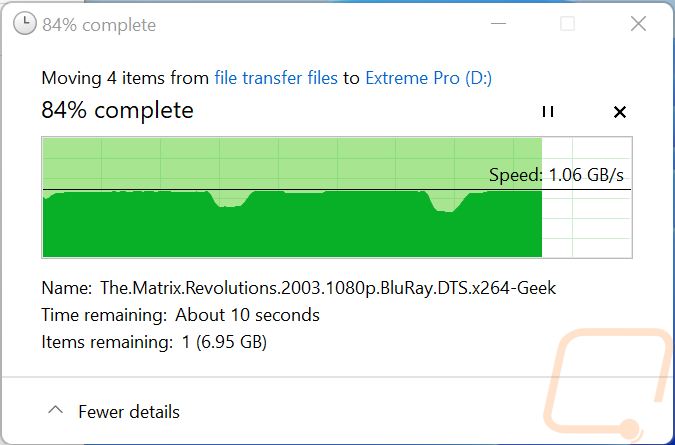
Movies to Extreme Pro Portable SSD v2
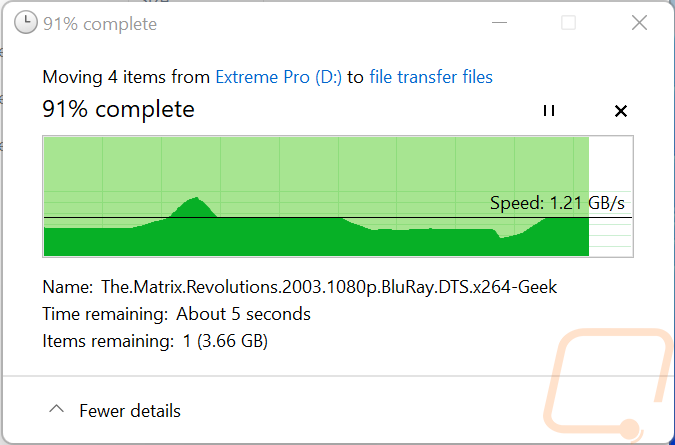
Movies to PC
For the medium-sized pictures, moving them to the Extreme PRO Portable SSD V2 started off slow but ramped up at the halfway point to level off at 600 MB/s. Moving those files back to the PC and reading them off the drive was significantly faster at 1.53 GB/s.
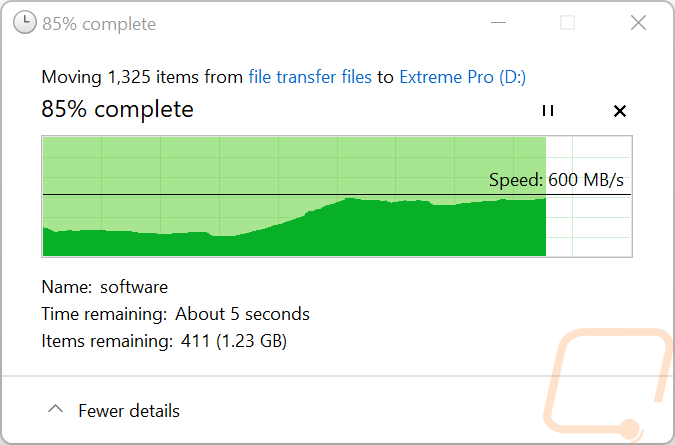
Pictures to Extreme Pro Portable SSD v2
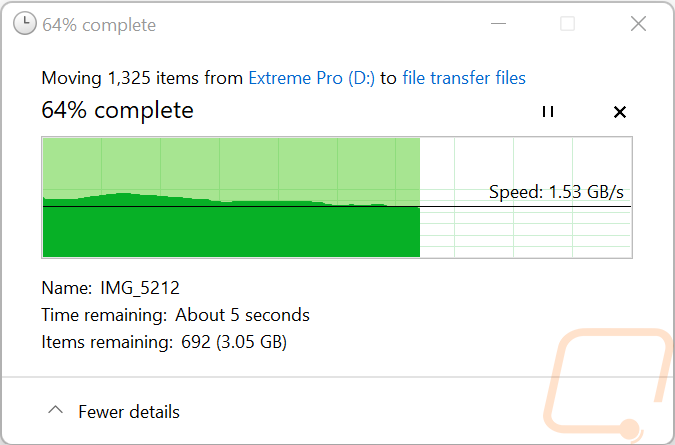
Pictures to PC
Last up the documents are known to slow things down to a craw and they did just that in comparison to the other file types. The Extreme PRO Portable SSD V2 started off at around 1.5 MB/s but ramped up to 2.9 MB/s and stayed there for the second half of the file transfer. Reading from the drive and moving those files back to the PC on the other hand was extremely quick at 11.2 MB/s the entire time.
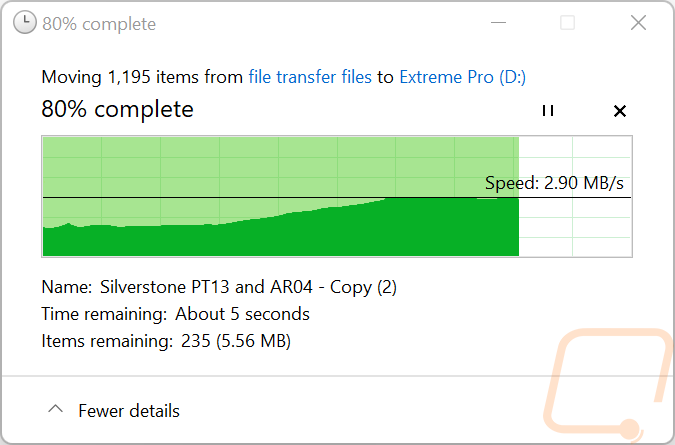
Documents to Extreme Pro Portable SSD v2
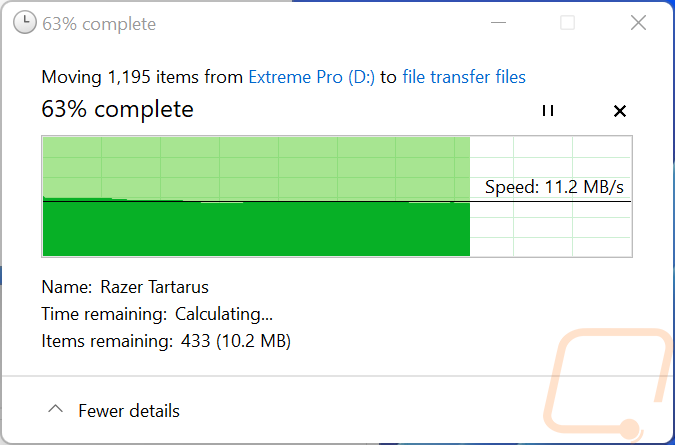
Documents to PC
Before finishing up I did run AIDA64’s linear read benchmark for a half hour to warm the Extreme PRO Portable SSD V2 up and then used the Flir to take a look at its thermals. The drive overall did warm up with even the coolest area running at 32.7c or 90f, warmer than our room temperature. The hottest area is mostly down near the USB connection but you can also see that the aluminum frame does pull that heat out across the drive. The backside of the drive without the extra rubber grip on top of it shows up a little warmer at 40c but that side shows the same temperature differential with more of the heat being close to the USB connection end of the drive. Overall this isn’t hot or an issue at all, but if you run the drive hard like that for an extended period don’t be surprised when it is warm when you grab it.


Overall and Final Verdict
I’ve had the chance over the years to check out a few of the different portable SSDs that SanDisk has brought out as well as options from other companies as well. While for my use, I typically keep them stored away in my laptop bag as I like to use them when traveling for my work and lots of tv shows or movies that I might be interested in watching. Not having to worry about any important data being lost from a bump or drop or maybe from water getting on the drive is why the SanDisk Extreme drives are often the drive I am using. With the Extreme PRO Portable SSD V2, SanDisk has continued that while also bumping up the performance with the USB 3.2 Gen 2x2 connection, doubling the speed of the previous generation and maxing out the connection speed once again. With my testing, the Extreme PRO Portable SSD V2 ran what SanDisk suggested it would run for basic sequential testing but I was even happier with its performance in our real-world file transfer testing. It was especially good when reading data back off of the drive in those tests but even write performance was still good. When it comes to huge drive capacities like this 4TB option, without those speeds it may take forever to fill or use the data you put on the drive. That is also why it is great that the Extreme PRO Portable SSD V2 is available up into this capacity.
The Extreme PRO Portable SSD V2’s design isn’t as small as some of the past SanDisk designs but it does continue to have the features that made the others stand out. The durable construction is one, but I also like that the drive has the hook integrated that could make it a large keychain or as a way to clip the drive somewhere you won’t lose it. The design while larger is still thin enough to slide into your pocket as well if that is what you would prefer. It is officially rated as being IP55 which means it is water and dust resistant for an extra layer of protection.
As far as pricing goes, the large capacity that our 4TB Extreme PRO Portable SSD V2 offers does also mean large capacity prices. The drive at the 4TB capacity costs a whopping $629.99 on the WD website and on Amazon. The 2TB model is $299 and the 1TB is $209 which makes the 4TB option the cheapest per/TB but it’s obvious that not everyone is going to be able to afford this monster. That is why there are cheaper options, even from the SanDisk lineup. This one specifically is getting you the fastest possible performance in the biggest capacity available right now.

Live Pricing: HERE




